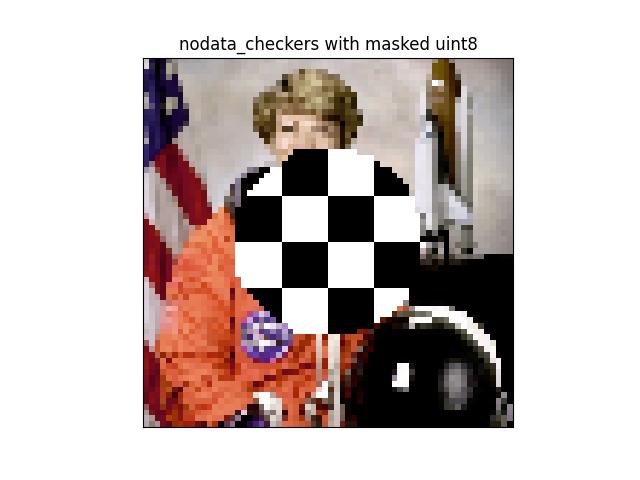kwimage.im_draw module¶
- kwimage.im_draw.draw_text_on_image(img, text, org=None, return_info=False, **kwargs)[source]¶
Draws multiline text on an image using opencv
- Parameters
img (ndarray | None | dict) – Generally a numpy image to draw on (inplace). Otherwise a canvas will be constructed such that the text will fit. The user may specify a dictionary with keys width and height to have more control over the constructed canvas.
text (str) – text to draw
org (Tuple[int, int]) – The x, y location of the text string “anchor” in the image as specified by halign and valign. For instance, If valign=’bottom’, halign=’left’, this where the bottom left corner of the text will be placed.
return_info (bool) – if True, also returns information about the positions the text was drawn on.
**kwargs – color (tuple): default blue
thickness (int): defaults to 2
fontFace (int): defaults to cv2.FONT_HERSHEY_SIMPLEX
fontScale (float): defaults to 1.0
valign (str): either top, center, or bottom. Defaults to “bottom” NOTE: this default may change to “top” in the future.
halign (str): either left, center, or right. Defaults to “left”.
border (dict | int): If specified as an integer, draws a black border with that given thickness. If specified as a dictionary, draws a border with color specified parameters. “color”: border color, defaults to “black”. “thickness”: border thickness, defaults to 1.
- Returns
the image that was drawn on
- Return type
ndarray
Note
The image is modified inplace. If the image is non-contiguous then this returns a UMat instead of a ndarray, so be carefull with that.
- Related:
The logic in this function is related to the following stack overflow posts [SO27647424] [SO51285616]
References
Example
>>> import kwimage >>> img = kwimage.grab_test_image(space='rgb') >>> img2 = kwimage.draw_text_on_image(img.copy(), 'FOOBAR', org=(0, 0), valign='top') >>> assert img2.shape == img.shape >>> assert np.any(img2 != img) >>> # xdoc: +REQUIRES(--show) >>> import kwplot >>> kwplot.autompl() >>> kwplot.imshow(img2) >>> kwplot.show_if_requested()
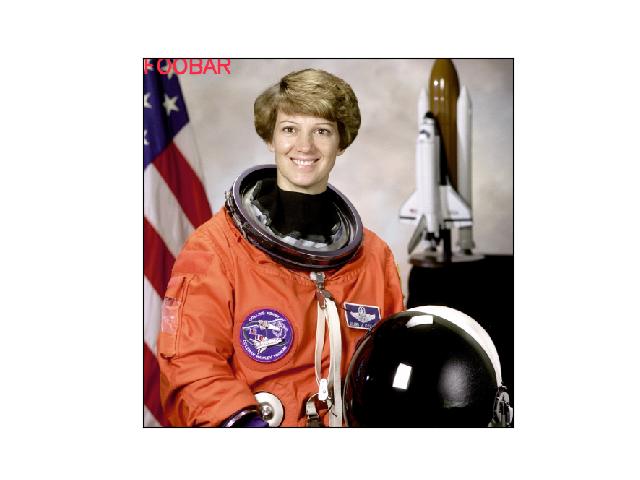
Example
>>> import kwimage >>> # Test valign >>> img = kwimage.grab_test_image(space='rgb', dsize=(500, 500)) >>> img2 = kwimage.draw_text_on_image(img, 'FOOBAR\nbazbiz\nspam', org=(0, 0), valign='top', border=2) >>> img2 = kwimage.draw_text_on_image(img, 'FOOBAR\nbazbiz\nspam', org=(150, 0), valign='center', border=2) >>> img2 = kwimage.draw_text_on_image(img, 'FOOBAR\nbazbiz\nspam', org=(300, 0), valign='bottom', border=2) >>> # Test halign >>> img2 = kwimage.draw_text_on_image(img, 'FOOBAR\nbazbiz\nspam', org=(250, 100), halign='right', border=2) >>> img2 = kwimage.draw_text_on_image(img, 'FOOBAR\nbazbiz\nspam', org=(250, 250), halign='center', border=2) >>> img2 = kwimage.draw_text_on_image(img, 'FOOBAR\nbazbiz\nspam', org=(250, 400), halign='left', border=2) >>> # xdoc: +REQUIRES(--show) >>> import kwplot >>> kwplot.autompl() >>> kwplot.imshow(img2) >>> kwplot.show_if_requested()
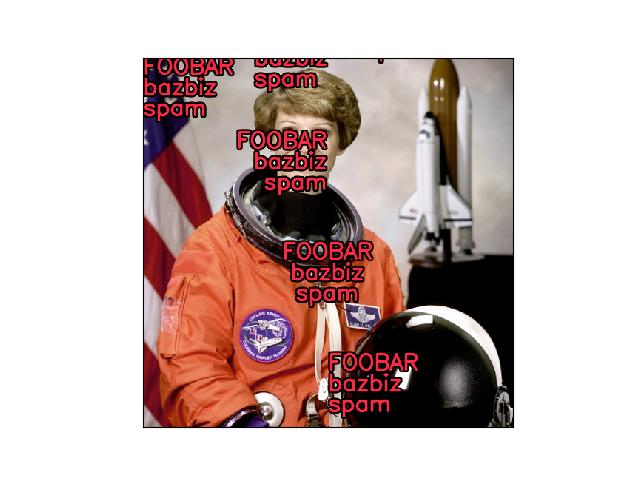
Example
>>> # Ensure the function works with float01 or uint255 images >>> import kwimage >>> img = kwimage.grab_test_image(space='rgb') >>> img = kwimage.ensure_float01(img) >>> img2 = kwimage.draw_text_on_image(img, 'FOOBAR\nbazbiz\nspam', org=(0, 0), valign='top', border=2)
Example
>>> # Test dictionary border >>> import kwimage >>> img = kwimage.draw_text_on_image(None, 'Battery\nFraction', org=(100, 100), valign='top', halign='center', border={'color': 'green', 'thickness': 9}) >>> #img = kwimage.draw_text_on_image(None, 'hello\neveryone', org=(0, 0), valign='top') >>> #img = kwimage.draw_text_on_image(None, 'hello', org=(0, 60), valign='top', halign='center', border=0) >>> # xdoc: +REQUIRES(--show) >>> import kwplot >>> kwplot.autompl() >>> kwplot.imshow(img) >>> kwplot.show_if_requested()
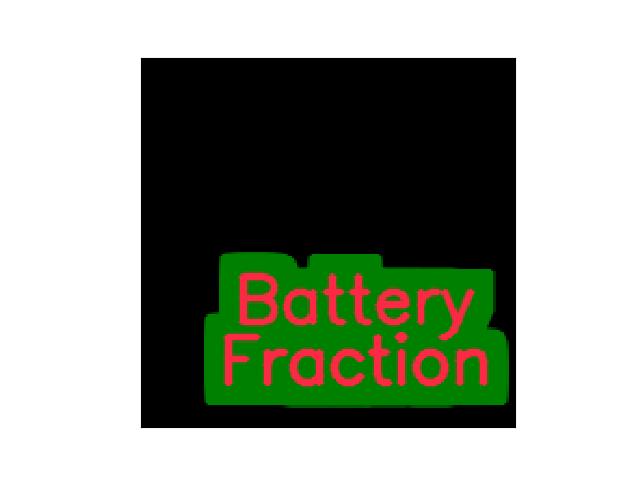
Example
>>> # Test dictionary image >>> import kwimage >>> img = kwimage.draw_text_on_image({'width': 300}, 'Unscrew\nGetting', org=(150, 0), valign='top', halign='center', border={'color': 'green', 'thickness': 0}) >>> print('img.shape = {!r}'.format(img.shape)) >>> # xdoc: +REQUIRES(--show) >>> import kwplot >>> kwplot.autompl() >>> kwplot.imshow(img) >>> kwplot.show_if_requested()

Example
>>> import ubelt as ub >>> import kwimage >>> grid = list(ub.named_product({ >>> 'halign': ['left', 'center', 'right', None], >>> 'valign': ['top', 'center', 'bottom', None], >>> 'border': [0, 3] >>> })) >>> canvases = [] >>> text = 'small-line\na-much-much-much-bigger-line\nanother-small\n.' >>> for kw in grid: >>> header = kwimage.draw_text_on_image({}, ub.repr2(kw, compact=1), color='blue') >>> canvas = kwimage.draw_text_on_image({'color': 'white'}, text, org=None, **kw) >>> canvases.append(kwimage.stack_images([header, canvas], axis=0, bg_value=(255, 255, 255), pad=5)) >>> # xdoc: +REQUIRES(--show) >>> canvas = kwimage.stack_images_grid(canvases, pad=10, bg_value=(255, 255, 255)) >>> import kwplot >>> kwplot.autompl() >>> kwplot.imshow(canvas) >>> kwplot.show_if_requested()
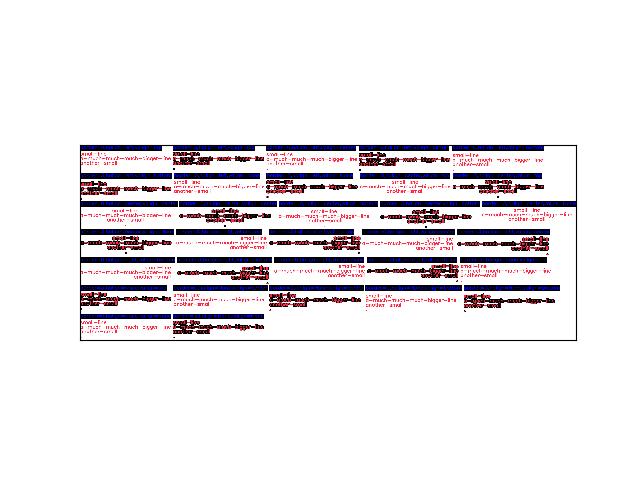
- kwimage.im_draw.draw_clf_on_image(im, classes, tcx=None, probs=None, pcx=None, border=1)[source]¶
Draws classification label on an image.
Works best with image chips sized between 200x200 and 500x500
- Parameters
im (ndarray) – the image
classes (Sequence[str] | kwcoco.CategoryTree) – list of class names
tcx (int) – true class index if known
probs (ndarray) – predicted class probs for each class
pcx (int) – predicted class index. (if None but probs is specified uses argmax of probs)
Example
>>> # xdoctest: +REQUIRES(module:torch) >>> import torch >>> import kwarray >>> import kwimage >>> rng = kwarray.ensure_rng(0) >>> im = (rng.rand(300, 300) * 255).astype(np.uint8) >>> classes = ['cls_a', 'cls_b', 'cls_c'] >>> tcx = 1 >>> probs = rng.rand(len(classes)) >>> probs[tcx] = 0 >>> probs = torch.FloatTensor(probs).softmax(dim=0).numpy() >>> im1_ = kwimage.draw_clf_on_image(im, classes, tcx, probs) >>> probs[tcx] = .9 >>> probs = torch.FloatTensor(probs).softmax(dim=0).numpy() >>> im2_ = kwimage.draw_clf_on_image(im, classes, tcx, probs) >>> # xdoctest: +REQUIRES(--show) >>> import kwplot >>> kwplot.autompl() >>> kwplot.imshow(im1_, colorspace='rgb', pnum=(1, 2, 1), fnum=1, doclf=True) >>> kwplot.imshow(im2_, colorspace='rgb', pnum=(1, 2, 2), fnum=1) >>> kwplot.show_if_requested()
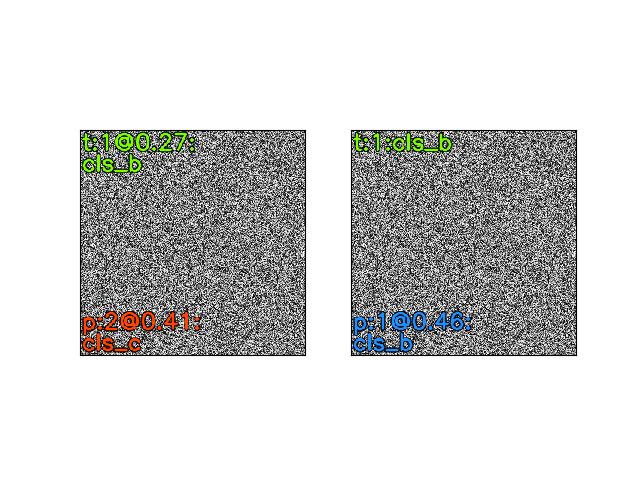
- kwimage.im_draw.draw_boxes_on_image(img, boxes, color='blue', thickness=1, box_format=None, colorspace='rgb')[source]¶
Draws boxes on an image.
- Parameters
img (ndarray) – image to copy and draw on
boxes (kwimage.Boxes | ndarray) – boxes to draw
colorspace (str) – string code of the input image colorspace
Example
>>> import kwimage >>> import numpy as np >>> img = np.zeros((10, 10, 3), dtype=np.uint8) >>> color = 'dodgerblue' >>> thickness = 1 >>> boxes = kwimage.Boxes([[1, 1, 8, 8]], 'ltrb') >>> img2 = draw_boxes_on_image(img, boxes, color, thickness) >>> assert tuple(img2[1, 1]) == (30, 144, 255) >>> # xdoc: +REQUIRES(--show) >>> import kwplot >>> kwplot.autompl() # xdoc: +SKIP >>> kwplot.figure(doclf=True, fnum=1) >>> kwplot.imshow(img2)
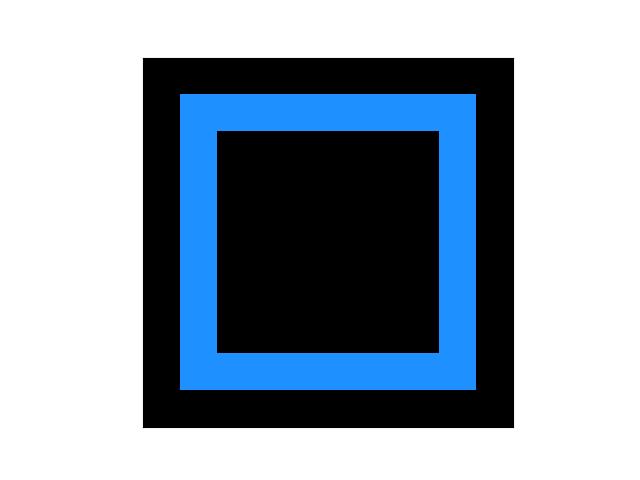
- kwimage.im_draw.draw_line_segments_on_image(img, pts1, pts2, color='blue', colorspace='rgb', thickness=1, **kwargs)[source]¶
Draw line segments between pts1 and pts2 on an image.
- Parameters
pts1 (ndarray) – xy coordinates of starting points
pts2 (ndarray) – corresponding xy coordinates of ending points
color (str | List) – color code or a list of colors for each line segment
colorspace (str) – colorspace of image. Defaults to ‘rgb’
thickness (int) – Defaults to 1
lineType (int) – option for cv2.line
- Returns
the modified image (inplace if possible)
- Return type
ndarray
Example
>>> from kwimage.im_draw import * # NOQA >>> pts1 = np.array([[2, 0], [2, 20], [2.5, 30]]) >>> pts2 = np.array([[10, 5], [30, 28], [100, 50]]) >>> img = np.ones((100, 100, 3), dtype=np.uint8) * 255 >>> color = 'blue' >>> colorspace = 'rgb' >>> img2 = draw_line_segments_on_image(img, pts1, pts2, thickness=2) >>> # xdoc: +REQUIRES(--show) >>> import kwplot >>> kwplot.autompl() # xdoc: +SKIP >>> kwplot.figure(doclf=True, fnum=1) >>> kwplot.imshow(img2)
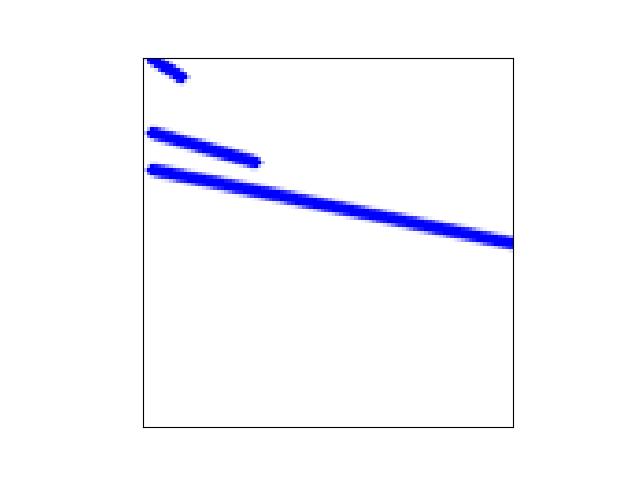
Example
>>> import kwimage >>> # xdoc: +REQUIRES(module:matplotlib) >>> pts1 = kwimage.Points.random(10).scale(512).xy >>> pts2 = kwimage.Points.random(10).scale(512).xy >>> img = np.ones((512, 512, 3), dtype=np.uint8) * 255 >>> color = kwimage.Color.distinct(10) >>> img2 = kwimage.draw_line_segments_on_image(img, pts1, pts2, color=color) >>> # xdoc: +REQUIRES(--show) >>> import kwplot >>> kwplot.autompl() # xdoc: +SKIP >>> kwplot.figure(doclf=True, fnum=1) >>> kwplot.imshow(img2)
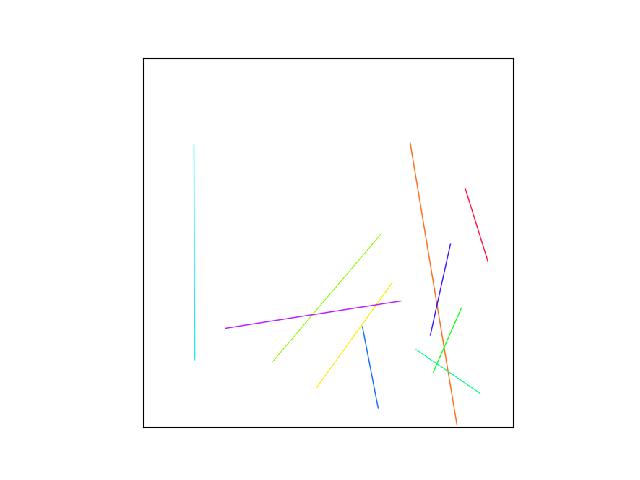
- kwimage.im_draw.make_heatmask(probs, cmap='plasma', with_alpha=1.0, space='rgb', dsize=None)[source]¶
Colorizes a single-channel intensity mask (with an alpha channel)
- Parameters
probs (ndarray) – 2D probability map with values between 0 and 1
cmap (str) – mpl colormap
with_alpha (float) – between 0 and 1, uses probs as the alpha multipled by this number.
space (str) – output colorspace
dsize (tuple) – if not None, then output is resized to W,H=dsize
- SeeAlso:
kwimage.overlay_alpha_images
Example
>>> # xdoc: +REQUIRES(module:matplotlib) >>> from kwimage.im_draw import * # NOQA >>> probs = np.tile(np.linspace(0, 1, 10), (10, 1)) >>> heatmask = make_heatmask(probs, with_alpha=0.8, dsize=(100, 100)) >>> # xdoc: +REQUIRES(--show) >>> import kwplot >>> kwplot.autompl() >>> kwplot.imshow(heatmask, fnum=1, doclf=True, colorspace='rgb', >>> title='make_heatmask') >>> kwplot.show_if_requested()
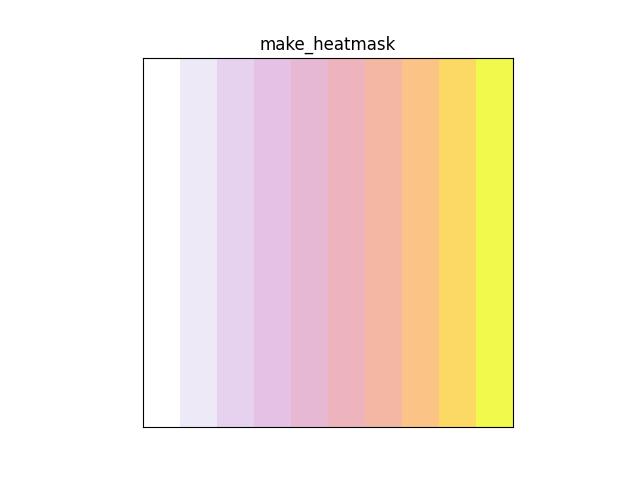
- kwimage.im_draw.make_orimask(radians, mag=None, alpha=1.0)[source]¶
Makes a colormap in HSV space where the orientation changes color and mag changes the saturation/value.
- Parameters
radians (ndarray) – orientation in radians
mag (ndarray) – magnitude (must be normalized between 0 and 1)
alpha (float | ndarray) – if False or None, then the image is returned without alpha if a float, then mag is scaled by this and used as the alpha channel if an ndarray, then this is explicilty set as the alpha channel
- Returns
an rgb / rgba image in 01 space
- Return type
ndarray[Any, Float32]
- SeeAlso:
kwimage.overlay_alpha_images
Example
>>> # xdoc: +REQUIRES(module:matplotlib) >>> from kwimage.im_draw import * # NOQA >>> x, y = np.meshgrid(np.arange(64), np.arange(64)) >>> dx, dy = x - 32, y - 32 >>> radians = np.arctan2(dx, dy) >>> mag = np.sqrt(dx ** 2 + dy ** 2) >>> orimask = make_orimask(radians, mag) >>> # xdoc: +REQUIRES(--show) >>> import kwplot >>> kwplot.autompl() >>> kwplot.imshow(orimask, fnum=1, doclf=True, >>> colorspace='rgb', title='make_orimask') >>> kwplot.show_if_requested()
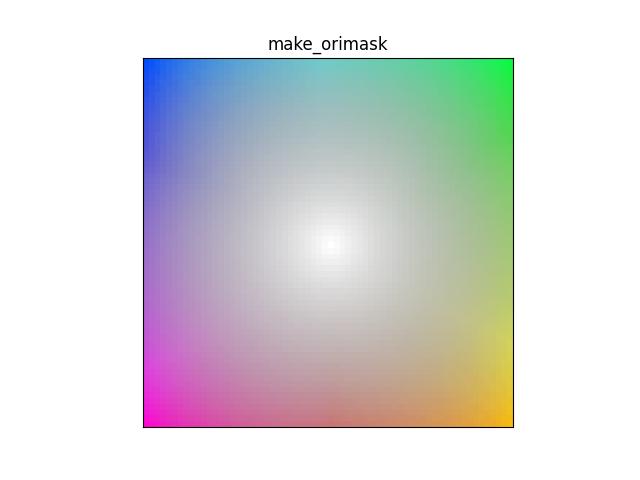
- kwimage.im_draw.make_vector_field(dx, dy, stride=0.02, thresh=0.0, scale=1.0, alpha=1.0, color='strawberry', thickness=1, tipLength=0.1, line_type='aa')[source]¶
Create an image representing a 2D vector field.
- Parameters
dx (ndarray) – grid of vector x components
dy (ndarray) – grid of vector y components
stride (int | float) – sparsity of vectors, int specifies stride step in pixels, a float specifies it as a percentage.
thresh (float) – only plot vectors with magnitude greater than thres
scale (float) – multiply magnitude for easier visualization
alpha (float) – alpha value for vectors. Non-vector regions receive 0 alpha (if False, no alpha channel is used)
color (str | tuple | kwimage.Color) – RGB color of the vectors
thickness (int) – thickness of arrows
tipLength (float) – fraction of line length
line_type (int | str) – either cv2.LINE_4, cv2.LINE_8, or cv2.LINE_AA or a string code.
- Returns
vec_img - an rgb/rgba image in 0-1 space
- Return type
ndarray[Any, Float32]
- SeeAlso:
kwimage.overlay_alpha_images
DEPRECATED USE: draw_vector_field instead
Example
>>> x, y = np.meshgrid(np.arange(512), np.arange(512)) >>> dx, dy = x - 256.01, y - 256.01 >>> radians = np.arctan2(dx, dy) >>> mag = np.sqrt(dx ** 2 + dy ** 2) >>> dx, dy = dx / mag, dy / mag >>> img = make_vector_field(dx, dy, scale=10, alpha=False) >>> # xdoctest: +REQUIRES(--show) >>> import kwplot >>> kwplot.autompl() >>> kwplot.imshow(img) >>> kwplot.show_if_requested()
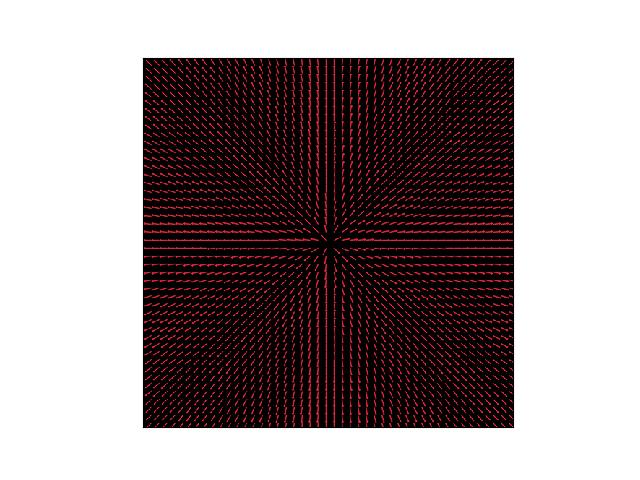
- kwimage.im_draw.draw_vector_field(image, dx, dy, stride=0.02, thresh=0.0, scale=1.0, alpha=1.0, color='strawberry', thickness=1, tipLength=0.1, line_type='aa')[source]¶
Create an image representing a 2D vector field.
- Parameters
image (ndarray) – image to draw on
dx (ndarray) – grid of vector x components
dy (ndarray) – grid of vector y components
stride (int | float) – sparsity of vectors, int specifies stride step in pixels, a float specifies it as a percentage.
thresh (float) – only plot vectors with magnitude greater than thres
scale (float) – multiply magnitude for easier visualization
alpha (float) – alpha value for vectors. Non-vector regions receive 0 alpha (if False, no alpha channel is used)
color (str | tuple | kwimage.Color) – RGB color of the vectors
thickness (int) – thickness of arrows
tipLength (float) – fraction of line length
line_type (int | str) – either cv2.LINE_4, cv2.LINE_8, or cv2.LINE_AA or ‘aa’
- Returns
The image with vectors overlaid. If image=None, then an rgb/a image is created and returned.
- Return type
ndarray[Any, Float32]
Example
>>> from kwimage.im_draw import * # NOQA >>> import kwimage >>> width, height = 512, 512 >>> image = kwimage.grab_test_image(dsize=(width, height)) >>> x, y = np.meshgrid(np.arange(height), np.arange(width)) >>> dx, dy = x - width / 2, y - height / 2 >>> radians = np.arctan2(dx, dy) >>> mag = np.sqrt(dx ** 2 + dy ** 2) + 1e-3 >>> dx, dy = dx / mag, dy / mag >>> img = kwimage.draw_vector_field(image, dx, dy, scale=10, alpha=False) >>> # xdoctest: +REQUIRES(--show) >>> import kwplot >>> kwplot.autompl() >>> kwplot.imshow(img, title='draw_vector_field') >>> kwplot.show_if_requested()
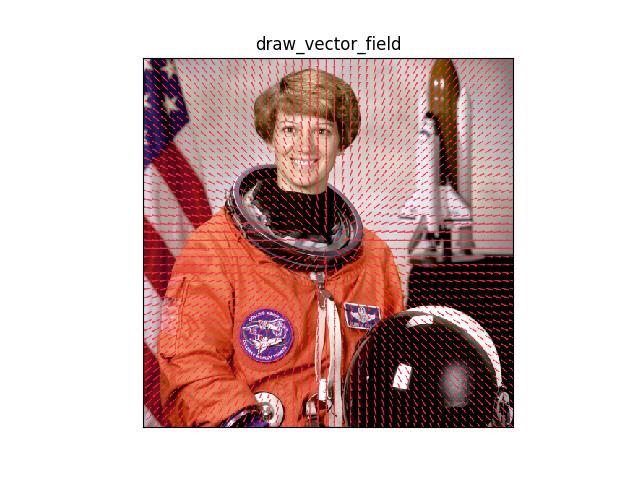
- kwimage.im_draw.draw_header_text(image, text, fit=False, color='strawberry', halign='center', stack='auto', bg_color='black')[source]¶
Places a black bar on top of an image and writes text in it
- Parameters
image (ndarray | dict | None) – numpy image or dictionary containing a key width
text (str) – text to draw
fit (bool | str) – If False, will draw as much text within the given width as possible. If True, will draw all text and then resize to fit in the given width If “shrink”, will only resize the text if it is too big to fit, in other words this is like fit=True, but it wont enlarge the text.
color (str | Tuple) – a color coercable to
kwimage.Color.halign (str) – Horizontal alignment. Can be left, center, or right.
stack (bool | str) – if True returns the stacked image, otherwise just returns the header. If ‘auto’, will only stack if an image is given as an ndarray.
- Returns
ndarray
Example
>>> from kwimage.im_draw import * # NOQA >>> import kwimage >>> image = kwimage.grab_test_image() >>> tiny_image = kwimage.imresize(image, dsize=(64, 64)) >>> canvases = [] >>> canvases += [draw_header_text(image=image, text='unfit long header ' * 5, fit=False)] >>> canvases += [draw_header_text(image=image, text='shrunk long header ' * 5, fit='shrink')] >>> canvases += [draw_header_text(image=image, text='left header', fit=False, halign='left')] >>> canvases += [draw_header_text(image=image, text='center header', fit=False, halign='center')] >>> canvases += [draw_header_text(image=image, text='right header', fit=False, halign='right')] >>> canvases += [draw_header_text(image=image, text='shrunk header', fit='shrink', halign='left')] >>> canvases += [draw_header_text(image=tiny_image, text='shrunk header-center', fit='shrink', halign='center')] >>> canvases += [draw_header_text(image=image, text='fit header', fit=True, halign='left')] >>> canvases += [draw_header_text(image={'width': 200}, text='header only', fit=True, halign='left')] >>> # xdoctest: +REQUIRES(--show) >>> import kwplot >>> kwplot.autompl() >>> pnum_ = kwplot.PlotNums(nCols=3, nSubplots=len(canvases)) >>> for c in canvases: >>> kwplot.imshow(c, pnum=pnum_()) >>> kwplot.show_if_requested()
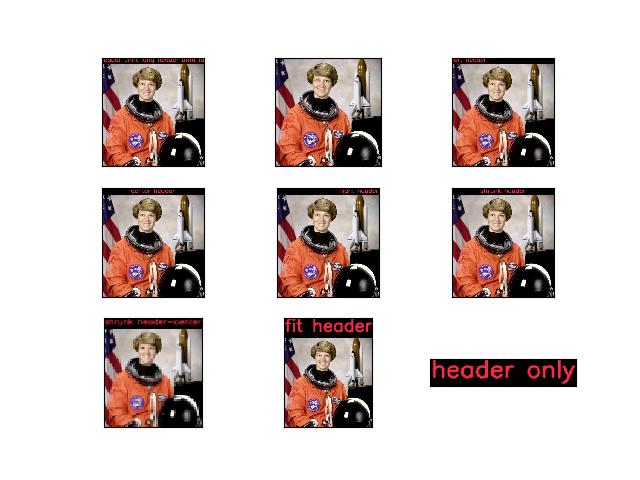
- kwimage.im_draw.fill_nans_with_checkers(canvas, square_shape=8)[source]¶
Fills nan values with a 2d checkerboard pattern.
- Parameters
canvas (np.ndarray) – data replace nans in
- Returns
the inplace modified canvas
- Return type
np.ndarray
- SeeAlso:
nodata_checkerboard()- similar, but operates on nans or masked arrays.
Example
>>> from kwimage.im_draw import * # NOQA >>> import kwimage >>> orig_img = kwimage.ensure_float01(kwimage.grab_test_image()) >>> poly1 = kwimage.Polygon.random(rng=1).scale(orig_img.shape[0] // 2) >>> poly2 = kwimage.Polygon.random(rng=3).scale(orig_img.shape[0]) >>> poly3 = kwimage.Polygon.random(rng=4).scale(orig_img.shape[0] // 2) >>> poly3 = poly3.translate((0, 200)) >>> img = orig_img.copy() >>> img = poly1.fill(img, np.nan) >>> img = poly3.fill(img, 0) >>> img[:, :, 0] = poly2.fill(np.ascontiguousarray(img[:, :, 0]), np.nan) >>> input_img = img.copy() >>> canvas = fill_nans_with_checkers(input_img) >>> assert input_img is canvas >>> # xdoc: +REQUIRES(--show) >>> import kwplot >>> kwplot.autompl() >>> kwplot.imshow(img, pnum=(1, 2, 1), title='matplotlib treats nans as zeros') >>> kwplot.imshow(canvas, pnum=(1, 2, 2), title='checkers highlight real nans')
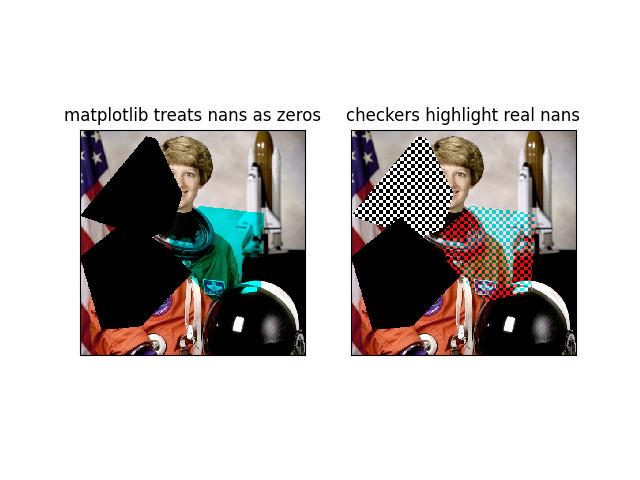
Example
>>> # Test grayscale >>> from kwimage.im_draw import * # NOQA >>> import kwimage >>> orig_img = kwimage.ensure_float01(kwimage.grab_test_image()) >>> poly1 = kwimage.Polygon.random().scale(orig_img.shape[0] // 2) >>> poly2 = kwimage.Polygon.random().scale(orig_img.shape[0]) >>> img = orig_img.copy() >>> img = poly1.fill(img, np.nan) >>> img[:, :, 0] = poly2.fill(np.ascontiguousarray(img[:, :, 0]), np.nan) >>> img = kwimage.convert_colorspace(img, 'rgb', 'gray') >>> canvas = img.copy() >>> canvas = fill_nans_with_checkers(canvas) >>> # xdoc: +REQUIRES(--show) >>> import kwplot >>> kwplot.autompl() >>> kwplot.imshow(img, pnum=(1, 2, 1)) >>> kwplot.imshow(canvas, pnum=(1, 2, 2))
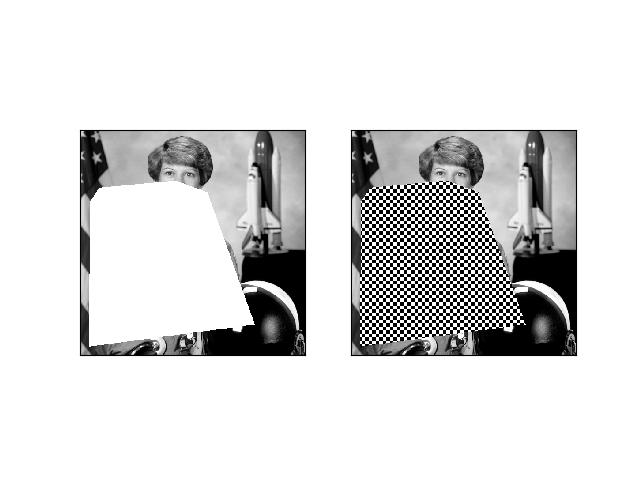
- kwimage.im_draw.nodata_checkerboard(canvas, square_shape=8)[source]¶
Fills nans or masked values with a checkerbord pattern.
- Parameters
canvas (ndarray) – A 2D image with any number of channels.
square_shape (int) – the pixel size of the checkers
- Returns
- an output array with imputed values.
if the input was a masked array, the mask will still exist.
- Return type
ndarray
- SeeAlso:
fill_nans_with_checkers()- similar, but only operates on nan values.
Example
>>> import kwimage >>> # Test a masked array WITH nan values >>> data = kwimage.grab_test_image(space='rgb') >>> na_circle = kwimage.Polygon.circle((256 - 96, 256), 128) >>> ma_circle = kwimage.Polygon.circle((256 + 96, 256), 128) >>> ma_mask = na_circle.fill(np.zeros(data.shape, dtype=np.uint8), value=1).astype(bool) >>> na_mask = ma_circle.fill(np.zeros(data.shape, dtype=np.uint8), value=1).astype(bool) >>> # Hack the channels to make a ven diagram >>> ma_mask[..., 0] = False >>> na_mask[..., 2] = False >>> data = kwimage.ensure_float01(data) >>> data[na_mask] = np.nan >>> canvas = np.ma.MaskedArray(data, ma_mask) >>> kwimage.draw_text_on_image(canvas, 'masked values', (256 - 96, 256 - 128), halign='center', valign='bottom', border=2) >>> kwimage.draw_text_on_image(canvas, 'nan values', (256 + 96, 256 + 128), halign='center', valign='top', border=2) >>> kwimage.draw_text_on_image(canvas, 'kwimage.nodata_checkerboard', (256, 5), halign='center', valign='top', border=2) >>> kwimage.draw_text_on_image(canvas, '(pip install kwimage)', (512, 512 - 10), halign='right', valign='bottom', border=2, fontScale=0.8) >>> result = kwimage.nodata_checkerboard(canvas) >>> # xdoc: +REQUIRES(--show) >>> import kwplot >>> kwplot.autompl() >>> kwplot.imshow(result) >>> kwplot.show_if_requested()
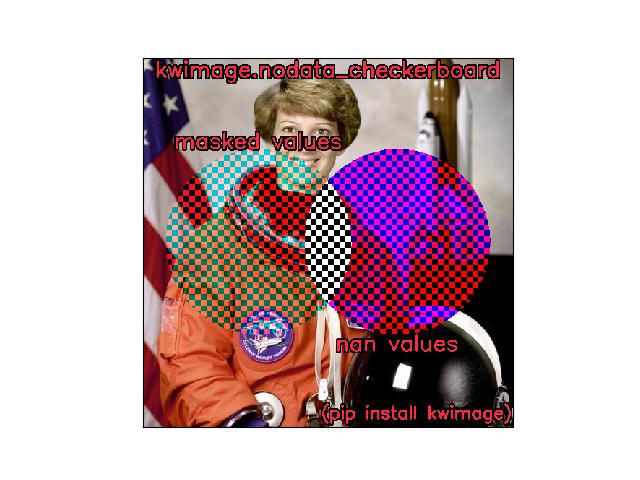
Example
>>> # Simple test with a masked array >>> import kwimage >>> data = kwimage.grab_test_image(space='rgb', dsize=(64, 64)) >>> data = kwimage.ensure_uint255(data) >>> circle = kwimage.Polygon.circle((32, 32), 16) >>> mask = circle.fill(np.zeros(data.shape, dtype=np.uint8), value=1).astype(bool) >>> img = np.ma.MaskedArray(data, mask) >>> canvas = img.copy() >>> result = kwimage.nodata_checkerboard(canvas) >>> canvas.data is result.data >>> # xdoc: +REQUIRES(--show) >>> import kwplot >>> kwplot.autompl() >>> kwplot.imshow(result, title='nodata_checkers with masked uint8') >>> kwplot.show_if_requested()
